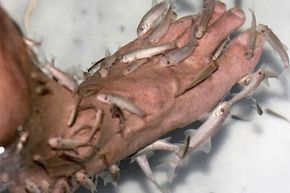One of the latest fads in skin care involves tanks of live fish, and it's stirring up quite a controversy. Garra rufa, or doctor fish as they're known to most of the world, have been used in spas across Europe and Asia for quite some time, but they weren't introduced to the United States until 2008. That's when a Virginia salon owner brought the fish home from a China spa and started offering doctor fish pedicures [source: Shishkin].
The fish originate in Turkey, where they've been used for more than 100 years to treat serious skin conditions such as psoriasis. The water temperatures there are high, which prevents many nutrients from surviving. As a result, doctor fish are basically starving and seem to have an insatiable appetite for dead skin [source: Atkins]. The popularity of doctor fish pedicures in the United States probably has as much to do with novelty as anything else. At the very least it's a creative way to exfoliate, and it seems to work.
Advertisement
However, if you think the whole thing sounds a little fishy, you're not alone. At least 14 state cosmetology boards agree with you. That's how many have banned the procedure on grounds that it's unsanitary, and more are likely to follow. The Virginia salon, however, remains unaffected for the time being. Virginia is not one of the fourteen states that have banned the use of doctor fish in spas.
If you're not quite sure how a doctor fish pedicure works, keep reading to find out.
Advertisement


